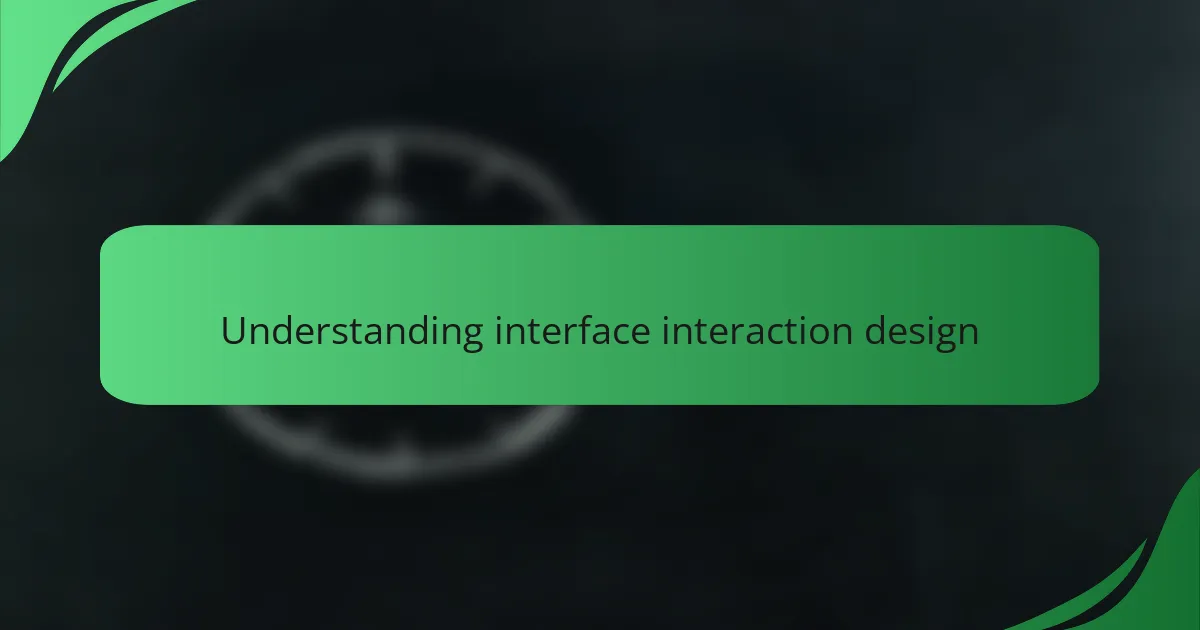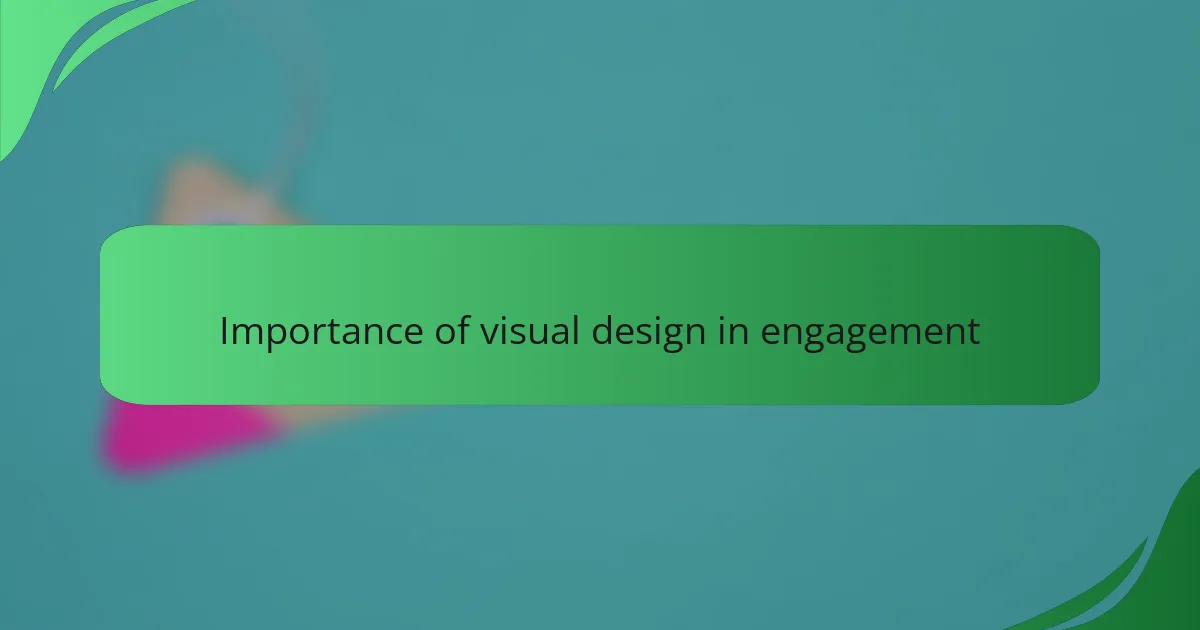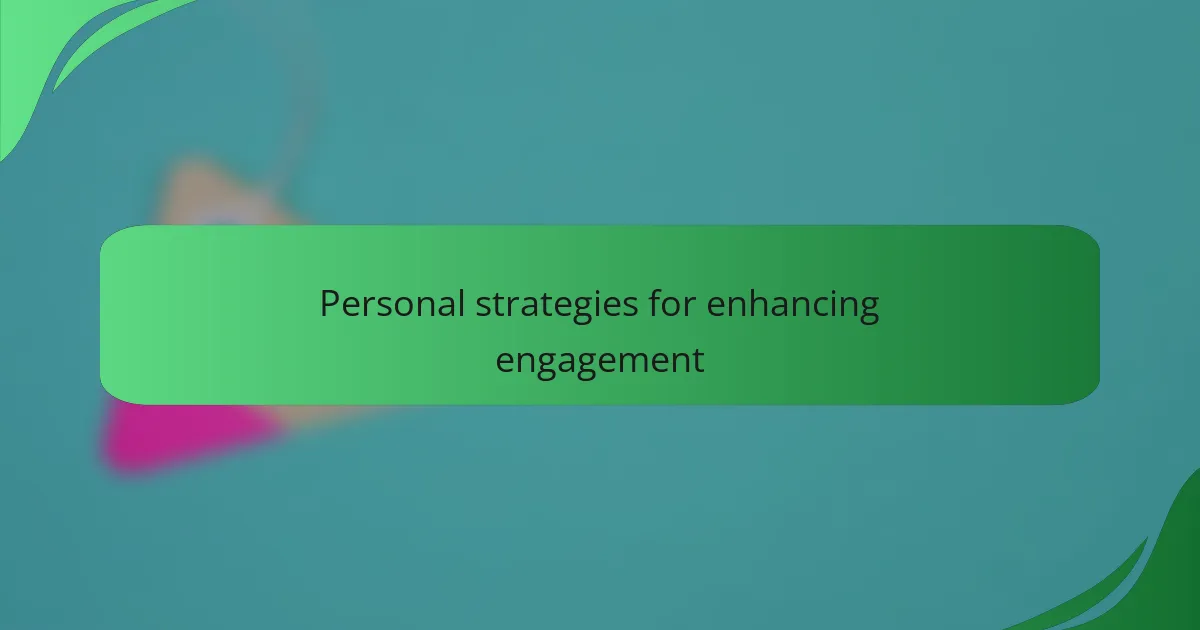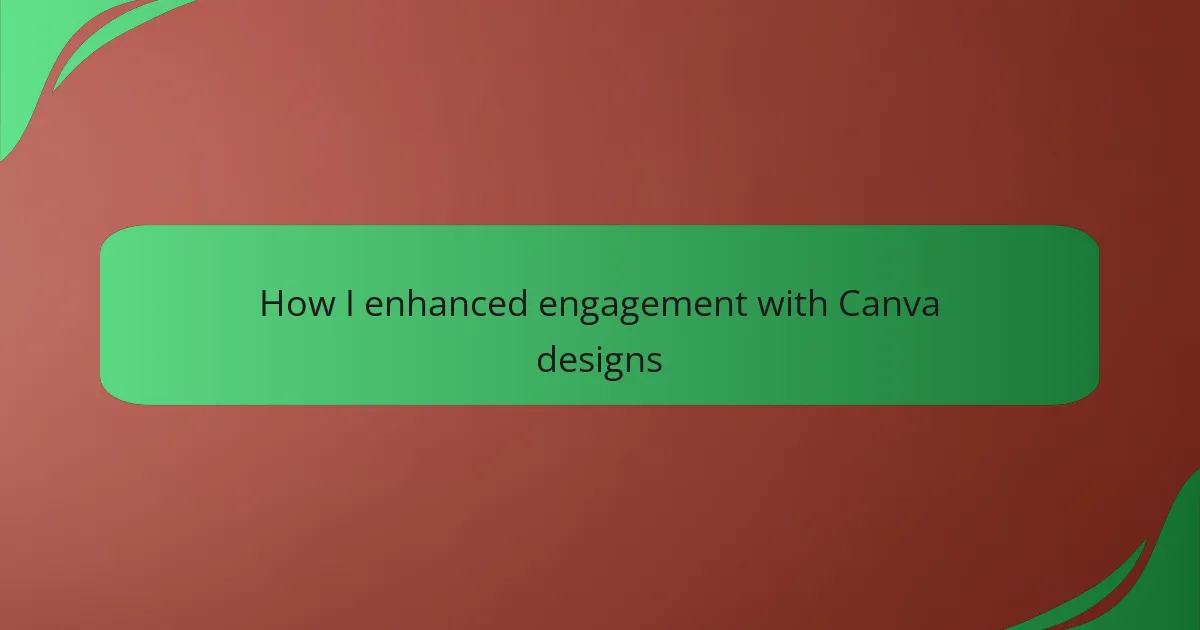Key takeaways
- Empathy in design is essential; understanding user needs enhances interface engagement.
- Simplicity and clarity in design can significantly improve user experience and interaction.
- Continuous feedback from users allows for dynamic design improvements and fosters community engagement.
- Visual elements play a crucial role in conveying messages quickly and emotionally connecting with users.

Understanding interface interaction design
Interface interaction design is all about how users engage with digital products. I’ve often found that the most effective designs are those that not only catch the eye but also facilitate intuitive navigation. Have you ever experienced frustration when trying to figure out how to use an app? That feeling underscores the importance of clear layout and user-friendly interactions.
When I first started exploring interface interaction design, I realized that empathy is crucial. Designers must consider the user’s perspective, anticipating their needs and behaviors. For instance, a well-placed call-to-action button can significantly increase engagement. It’s fascinating how a small change can lead to a more satisfying experience.
Moreover, usability testing is an essential part of the design process. I remember conducting a few tests myself, where real users interacted with my designs. Their feedback was invaluable; it revealed not just their struggles but also what excited them. Those moments of insight truly shaped my understanding of what makes an interface engaging and effective.

Key principles of effective engagement
One key principle of effective engagement is clarity. When I started using Canva for my designs, I realized that simplicity could be powerful. Have you ever been overwhelmed by too many elements on a page? Stripping away the clutter and focusing on straightforward messages can significantly enhance user experience and keep users coming back.
Another important aspect is emotional connection. I often think about how colors and images evoke specific feelings. For instance, using warm tones in a design can create a welcoming atmosphere. Remember that moment when a design just resonated with you? That’s the kind of response I strive for, as engaging designs can truly make users feel understood.
Lastly, incorporating feedback loops is essential for sustained engagement. Early on, I learned the value of adjusting my designs based on user feedback. Have you ever asked someone about their experience with a product, only to realize there were features they loved or others they found confusing? Listening to users helps create a dynamic interaction, fostering a sense of community and investment in the product.

Importance of visual design in engagement
Visual design plays a pivotal role in engagement on digital platforms. From my experience, well-crafted visuals can evoke emotions and create a connection between users and content. For instance, when I redesigned my own website using Canva, I noticed a significant increase in user interactions. Eye-catching graphics not only capture attention but also enhance the overall user experience, making the content more digestible and appealing.
Another crucial aspect is how visual elements help convey messages quickly. I often observe that images can communicate ideas far more efficiently than text, which is vital in our fast-paced digital environment. This has led me to prioritize visuals in my designs, allowing users to grasp concepts at a glance, thus encouraging longer visits and deeper engagement.
Here’s a comparison of visual design elements and their impact on engagement:
| Design Element | Impact on Engagement |
|---|---|
| Color Schemes | Influences mood and perception |
| Typography | Affects readability and accessibility |
| Images and Graphics | Enhances understanding and retention |
| Layout and Spacing | Guides user navigation and focus |

Overview of Canva design features
Canva offers a wide range of design features that cater to both beginners and experienced designers. One of my favorite aspects is the intuitive drag-and-drop interface, which simplifies the design process and makes crafting visuals feel almost effortless. I remember my first time using Canva; it was exciting to see my ideas come to life so quickly, and I appreciated how user-friendly it was.
The platform includes a vast library of templates, images, and fonts, allowing for endless customization. I find it particularly beneficial for enhancing user engagement on my website, as it helps create visually appealing content that captures attention. The collaboration features also stand out to me; working with a team becomes seamless and enjoyable when everyone can contribute ideas in real time.
Here’s a quick comparison table of some key Canva design features to highlight their strengths:
| Feature | Description |
|---|---|
| Drag-and-Drop Interface | User-friendly design tool that simplifies creating graphics |
| Template Library | A vast selection of customizable templates for various needs |
| Collaboration Tools | Enables real-time teamwork and feedback among users |
| Image and Font Library | Access to thousands of images and fonts for design variety |

Personal strategies for enhancing engagement
When I first started using Canva for my designs, I realized that the visuals could significantly impact user engagement. I began experimenting with colorful palettes and dynamic layouts, which made my content instantly more appealing. The excitement I felt when I saw an increase in interactions was truly rewarding—it was like unlocking a new level in a game!
Over time, I’ve developed a few key strategies that consistently enhance engagement:
- Utilize Interactive Elements: Incorporating clickable buttons and links encourages users to interact more.
- Personalize with Brand Consistency: Using my brand colors and fonts keeps everything cohesive and familiar to users, enhancing trust.
- Test with A/B Variants: I often create two versions of a design to gauge which resonates better with my audience.
- Emphasize Storytelling: I weave narratives through visuals; it draws users in emotionally and keeps them coming back.
- Incorporate User Feedback: Utilizing surveys or comments allows me to adapt my designs based on what the audience truly wants to see.

Case studies of successful Canva designs
When I started using Canva to enhance engagement on my website, I discovered some incredible case studies that resonated deeply with my audience. One particular example was a non-profit’s marketing campaign that used vibrant visuals and compelling infographics to tell their story. They saw a 40% increase in community participation, proving that captivating design can significantly affect engagement.
Another case involved a business that revamped their social media presence through Canva. They created a series of cohesive posts that reflected their brand’s voice and ethos. In just a few weeks, their follower count skyrocketed, and they received numerous inquiries about their services. It taught me that consistency in design fosters familiarity and trust.
Here are some key takeaways from successful Canva designs:
- Visual storytelling: Engaging visuals can convey a message succinctly and emotionally.
- Color psychology: Certain colors can evoke feelings and influence decisions; knowing this helped enhance my designs.
- Brand consistency: Maintaining a cohesive look across all platforms strengthens brand identity.
- User-generated content: Incorporating community feedback into designs can create a sense of ownership and connection.
- Call-to-action effectiveness: Clear, well-designed CTAs can dramatically increase user interaction and conversion rates.

Lessons learned from my design process
Throughout my design journey with Canva, I discovered that the collaborative aspects of the platform can significantly enhance engagement. For instance, while working on a project with a small team, we quickly realized the value of incorporating each member’s ideas into the designs. This not only fostered a sense of ownership but also led to more diverse and vibrant final products. It felt rewarding to see our collective brainstorming come to life, proving that teamwork can take any design to the next level.
On the technical side, I learned how crucial it is to pay attention to color schemes and typography. I remember experimenting with various combinations for a particular poster, and those small details made all the difference. By taking the time to ensure the visuals aligned with the intended message, I felt a personal sense of accomplishment witnessing the final design resonate with the audience.
Here are some key lessons I learned:
- Embrace collaboration: Working with others can spark creativity and lead to better designs.
- Focus on details: Small elements like color and font can significantly impact viewer engagement.
- Iterate designs: Don’t shy away from going through multiple drafts; it’s part of the process.
- Gather feedback: Sharing your work often can provide insights you might have missed.
- Be open to change: A willingness to adapt your designs based on feedback is crucial for improvement.



